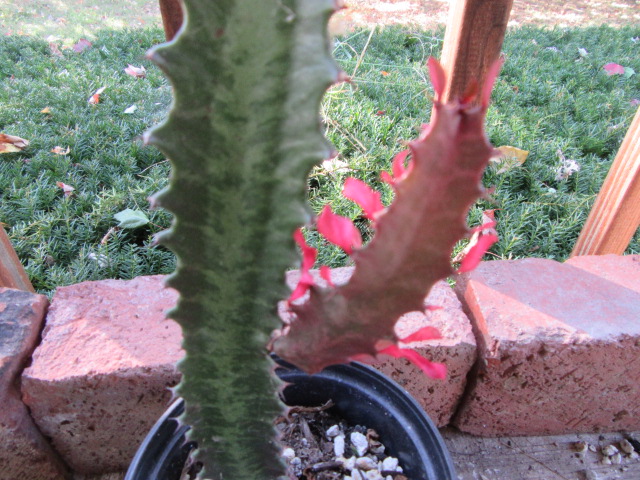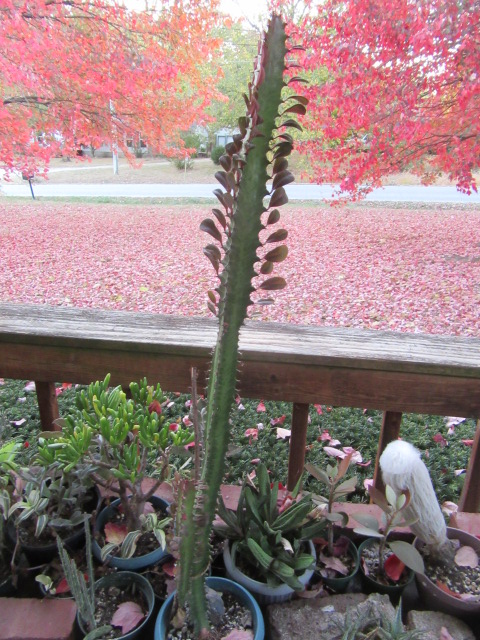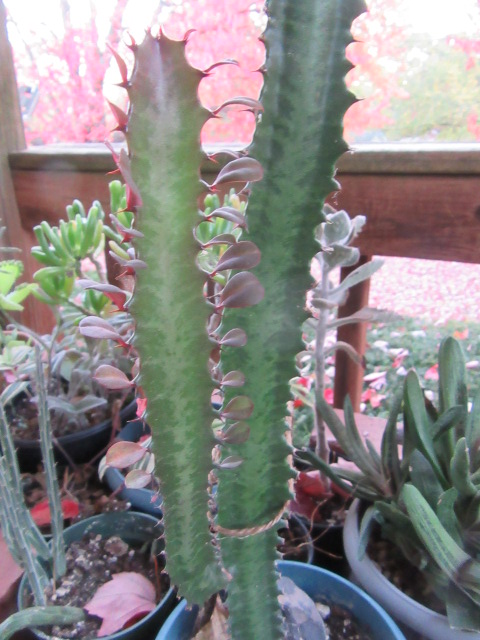
Euphorbia trigona ‘Rubra’ (African Milk Tree) at 6 1/4″ tall on 6-24-21, #803-8.
African Milk Tree, African Milk Bush, Candelabra Cactus, Cathedral Cactus, Abyssinian Euphorbia, High Chaparral
Euphorbia trigona
you-FOR-bee-uh try-GOH-nuh
Euphorbia trigona Mill. is the accepted scientific name for the African Milk Tree. It was named and described as such by Philip Miller in the 8th edition of Gardener’s Dictionary in 1768.
The genus, Euphorbia L., was named and described as such by Carl von Linnaeus in the first volume of the first edition of Species Plantarum in 1753.
As of 12-17-23 when this page was last updated, Plants of the World Online lists 2,040 species in the Euphorbia genus. It is a member of the plant family Euphorbiaceae with 228 genera. Those numbers could change as updates are made on POWO. The number of species in the genus fluctuates often.
THERE ARE SEVERAL LINKS AT THE BOTTOM OF THE PAGE FOR FURTHER READING.

Euphorbia trigona ‘Rubra’ (African Milk Tree) on 6-24-21, #803-9.
I was at Mast’s Greenhouse on June 18 in 2021 browsing to see what they possibly had left. I don’t go to Mast’s that often like I do Wagler’s, but I may go once a year. There wasn’t much left as far as bedding plants and perennials were concerned, but they still had several succulents. What was weird was that they had them sitting in flats full of water. I could tell they had been sitting in the water for quite some time because algae was growing in the water and their potting soil was soaked. It is possible they didn’t leave the pots in the water for an extended time, but it didn’t appear to be that way. I decided I would pick up this particular plant and bring it home. I didn’t have any like it and it looked very interesting. The plant measured 6 1/4″ tall, not including the leaves when I brought it home.
The pot was unlabeled, as are a lot of their succulents they take their own cuttings from. Upon a little research, and I mean very little, I found out this plant is likely Euphorbia trigona. Well, to be honest with you, I put these first two photos on the Facebook group called Succulent Infatuation. One member suggested it was Euphorbia trigona rubra and I believe they were right. Euphorbia trigona rubra isn’t an “official” scientific name and there is no evidence it ever was. There are rules to taxonomy when it comes to naming plants. 🙂

Euphorbia trigona ‘Rubra’ (African Milk Tree) on 6-24-21, #803-10.
I checked Llifle (Encyclopedia of Living Forms) for photos and a description of the species. There is a very good write-up about the species but no photos. They also have a page, with photos, of Euphorbia trigona ‘Royal Red’. While the plant I brought home does have a reddish tint, it didn’t appear to be near as red as ‘Royal Red’.

Euphorbia trigona ‘Rubra’ (African Milk Tree) at 10 3/4″ tall (not including the leaves) on 8-17-21, #826-21.
The Euphorbia trigona is considered a tender evergreen succulent. It is thought they come from Central Africa and is possibly of hybrid origin. Some websites say this species grows “among thickets” in their native environment, but others say they are ONLY grown in cultivation. Some say it is from India, while others say Angola in Central Africa…
The species name, trigona, comes from its three-angled stems with distinctive V-shaped patterns.

Euphorbia trigona ‘Rubra’ (African Milk Tree) on 8-17-21, #826-22.
The three-angled stems of the Euphorbia trigona are very shiny and waxy in texture. The ridges appear winged and toothed. The “teeth” have two sharp thorns each.

Euphorbia trigona ‘Rubra’ (African Milk Tree) on 8-22-21, #829-1.
Information online says the leaves are “drop” or “teardrop” shaped. They grow between the two thorns on the plant’s teeth. There is also contradictory information about how long the leaves last. LLIFLE say they fall off during the winter but in some cases, depending on how grown, can last for several years. Some websites seem to indicate once they fall off, that is it. If it is like other Euphorbia species I have grown, the leaves grow during the summer and fall off during the winter when inside.
On August 22 in the afternoon, I was on the front porch when the succulents were basking in the sun. The Euphorbia trigona was glowing… It was really neat

Euphorbia trigona ‘Rubra’ (African Milk Tree) on 8-22-21, #829-2.
As with other species in the genus, Euphorbia trigona produces a milky latex sap. The sap is poisonous and can cause eye and skin irritation. If ingested, it can also screw around with your digestion system… So, it may be advisable to keep your plant away from pets and small children.

Euphorbia trigona ‘Rubra’ (African Milk Tree) on 8-22-21, #829-3.
Some websites will tell you that Euphorbia trigona produces yellow-white flowers. Well, folks, the experts say it may take 20-60 years for that to happen and it won’t happen PERIOD if they are grown in pots. Some websites, like LLIFLE, say they are only known in cultivation and have never flowered. However, this page on World of Succulents shows flowers… Hmmm… Well, I am not growing this plant for its flowers.
Now, its size is also important. I find it to be a fast grower since it grew about 4″ in only two months. I am sure it may not grow much over the winter, but time will tell. This species will grow tall and produce offsets and branches. It is advisable not to grow this plant in windy locations once it has multiple branches or the thorns can damage the stems.
Since I haven’t had this plant for long, I can only share what others have written about. Experience is the best teacher so I will share my experience and more photos as time goes by.
USEFUL INFORMATION:
Family: Euphorbiaceae
Origin: Probably Central Africa
Zones: USDA Zones 9b-11(24 to 40° F/-3.8 to 4.5° C)
Size: Hmmm… 6, 7, 8 , 9’… Experience will tell you.
*Light: Light to part shade. Does not like direct sun.
**Soil: Very well-draining. See below.
***Water: Regular watering during the summer, barely if any during the winter. Rot prone…
*During the summer, I keep most of my cacti on the back deck where they receive full sun. Most of the succulents are on the front porch where they receive direct sun only a few hours in the afternoon. During the winter most cacti aren’t picky about the light because they are basically dormant. For several winters, mine were in front of the east-facing sliding door in the dining room so they didn’t get much light but they did great. Most of the succulents are on a shelf in a south-facing window in a cool bedroom but a few are in my bedroom. The cacti are either on a shelf in my bedroom for the winter or in front of the east-facing sliding door.
**When it comes to potting soil, finding the “sweet spot” is not exactly that easy when materials are limited. Cactus and succulent enthusiasts (and experts) do not recommend using peat-based commercial mixes but what choice is there for most of us. They say to use a loam-based mix… Hmmm… Our soil is loam, so do I just use dirt? Well, no because “dirt” is heavy and you need a “light” material. There is A LOT of cactus and succulent recipes online and some get pretty elaborate. Many say to use sand as an ingredient, but if you do that, it needs to be very coarse, like builders sand, because “ordinary” sand, like for sandboxes, is too fine and it clogs up the air space between the coarser ingredients. For MANY years I used 2 parts Miracle Grow or Schultz Potting amended with an additional 1 part of perlite and 1 part chicken grit. Schultz doesn’t seem to have as many large pieces of bark. Cactus and succulent enthusiasts recommended using pumice instead of perlite and grit so I checked it out… The “guy” at General Pumice (online) recommended using a 50/50 mix of potting soil and pumice. General Pumice has 3 different sizes to choose from depending on the size of the pot. SO, in 2018 I bought a bag of 1/8″ and mixed it 50/50 with Miracle Grow Potting Soil. I liked it pretty well. Then in 2020, since most of the cactus were in larger pots, I ordered the 1/4″ size. Pumice has a lot of benefits over perlite and has nutrients that are added to the soil when watering. Pumice is also heavier so it stays mixed in the soil instead of “floating” to the top. Still, there is the issue of the mix getting very hard once you stop watering the plants during the winter when you stop watering. I think this is because of the peat in the potting soil… SO, instead of re-potting the cactus and succulents in the spring, I started doing it during the fall and winter so their soil would be loose. Since you don’t water as frequently during the winter if at all, the timed-release fertilizer does not activate. I have not tried coir, but I am looking into it…
You have to sort of mimic the soil where species grow in their native habitat. For that, you almost have to go see for yourself… Typically, they grow in fairly rocky soil.
***I water my cactus and succulents regularly during the summer but barely ever in the winter (maybe a little in January) until close to time to take them back outside.
You can read my Cactus Talk & Update and Cactus & Succulent Tips to get my opinion about growing cactus and succulents.
When you bring your new plants home from the store, you need to check their roots and the soil to see if they are wet. If so, you may want to re-pot it right away. It is advisable to re-pot them in a better potting soil more suitable for cactus and succulents.
<<<<2022>>>>

Euphorbia trigona ‘Rubra’ (African Milk Tree) at 19 1/2″ tall on 10-16-22, #919-11.
When I moved the plants inside for the winter on October 16 in 2022, I was shocked it had grown to 19 1/2″ tall. Earlier, I noticed it had started growing a branch.

Euphorbia trigona ‘Rubra’ on 10-16-22, #919-12.
Glowing in the sun…
<<<<2023>>>>

Euphorbia trigona ‘Rubra’ (African Milk Tree) at 30 3/4″ tall on 10-23-23, #967-13.
Even though there was no “F” in the forecast until October 30 in 2023, it was going to be a rainy week so I moved the potted plants inside on the 23rd and 24th. Time for photos and measurements…
The Euphorbia trigona ‘Rubra’ GREAT well during the summer on the front porch despite the heat and drought. It measured a whopping 30 3/4” tall with a 9″ branch when I moved it inside for the winter.

Euphorbia trigona ‘Rubra’ (African Milk Tree) branch at 9″ tall on 10-23-23, #967-14.
I hope you enjoyed this page and maybe found it useful. If you have any comments, questions, or suggestions, I would like to hear from you. Please click on “like” if you visited this page. It helps us bloggers stay motivated. 🙂 You can check out the links below for further reading. The links take you directly to the genus and species of this plant. If you see I have made an error, please let me know in a comment or email me at thebelmontrooster@yahoo.com.